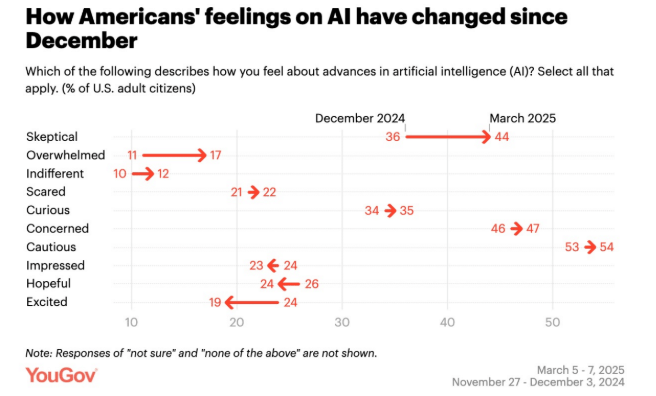- Leading Disruption
- Posts
- Addressing AI Fears Head-On
Addressing AI Fears Head-On
"Am I still needed?"
That's the question keeping your employees up at night. Not "How does this AI tool work?" or "What's the ROI?"
AI resistance in organizations isn’t a technology problem. The tools exist, they work, and they’ve transformed the future of work. Resistance to AI adoption in the workplace is actually a matter of identity, as workers ask a key question:
"Who am I if a machine can do my job?"

AI Resistance is Growing
Recent data from YouGov shows something alarming. In just four months, from December 2024 to March 2025, American attitudes toward AI have shifted dramatically in the wrong direction:
🫤 Skeptical: 36% → 44%
😵💫 Overwhelmed: 11% → 17%
😰 Scared: 11% → 22%
🤩 Excited: 24% → 19%
Here's what I've learned after years of helping organizations navigate disruption: change always comes with fear. It’s how leaders implement change that makes a difference.

Beyond the Fear: What People Really Want
When someone says "I'm afraid AI will take my job," they're not asking for a technical demo. They're expressing a deeper need:
➡️ "I'm afraid of losing my job" = I want security and meaningful work.
➡️ "I fear losing control" = I want autonomy and agency.
➡️ "I don't trust AI to make decisions" = I want safety with human oversight.
➡️ "I'm afraid of being replaced" = I want purpose beyond my tasks.
➡️ "I fear being left behind" = I want opportunities to learn and grow.
These are fundamentally human anxieties about identity, belonging, and worth. These are concerns that no amount of technical training can address. Instead, it’s up to leaders to hear the humanity of these anxieties and build spaces where employees can come to AI from a place of security and psychological safety.
The Questions Your People Are Really Asking
Behind every "How does this work?" is a more vulnerable question. Your employees may wonder if they’re still needed, what their purpose is if AI replaces key tasks, and what value they have to your organization.
As leaders, we have to create space for these conversations. Not just "Here's your AI training—go use it." But real dialogue about identity, purpose, and value in an AI-augmented world.
What You Can Promise…And What You Can’t
You can't promise:
🔹 Guaranteed job security
🔹 That careers will stay frozen in time
🔹 That all jobs will remain unchanged
You can promise:
🔹 Investment in their growth and future skills
🔹 Tools to adapt, evolve, and thrive
🔹 New pathways and opportunities with AI
🔹 Support for their development, wherever it leads them
As a leader, I've always believed in discussing someone's last day of work on their first day. It helps us face the honest fact that we won’t be working together forever—and that’s been true since before AI changed the world. But while we're aligned, we'll maximize your potential so you can grow confidently.
Building Trust Through Action
Here are practical ways to address AI fear in your organization:
Weekly storytelling: Share concrete AI wins without the hype. Show real progress and real impact. How did AI enable employees to do more with their time?
Monthly check-ins: Create psychological safety to discuss fears and anxieties openly.
Quarterly showcases: Celebrate both successes AND failures. Show when AI didn't work, and what you learned.
Curiosity channels: Create informal spaces in Slack or Teams for people to share experiments and questions.
Make humans visible: Show clearly where humans are in the loop. People need to see there's oversight and accountability.
Your AI Empowerment Pledge
Consider creating something like this for your organization:
"In our organization, AI enhances, not replaces human potential. AI amplifies creativity, collaboration, and impact. Together, we design an AI-augmented future we are proud of."
The key distinction: We can't guarantee jobs, but we value YOU. Your contributions, knowledge, and passion for serving customers are not replaceable.
A Special Note for Fearful Leaders
If you're a leader who's frightened of AI, you must address your own fears first. Your team will sense your uncertainty. They need to see you modeling curiosity, vulnerability, and growth.
Start with your top two leadership levels. Give them time and space to explore AI, ask any questions, and work through their own identity shifts. Until they're confident with AI, they can't lead that transformation for others.
Remember: People want two things from their leaders: honesty and fairness. Be honest about the uncertainty. Be fair in your support and investment in their future.
The organizations that acknowledge these deeper fears and invest in people as well as tools are the ones where teams don't resist AI. They run with it.
🗣️ Your Turn
What fears are you seeing in your organization? How are you addressing the identity questions behind AI resistance?
What I Can’t Stop Talking About
AI anxiety can spike if your AI adoption strategy is disjointed. Think about AI as a series of Lego bricks and build a tower that’s designed to be modular.
The human parts of our work mean more than ever. If you’re focused on what AI could take away, you’ll miss the freedom, time, and creativity it has to offer.
My Upcoming Appearances/Travel
Aug 29: Indy SHRM Annual Conference Keynote, Indianapolis, IN
Sep 17: Private Client, London, UK
Sep 21-22: Singapore Ministry of Health, Singapore
Oct 7: Keynote, Reston, VA
Oct 15: Executive Women's Forum, Keynote, Denver, CO
Nov 13: Brilliance 2025, Celebrating Women Disrupting Healthcare Keynote, Chicago, IL

If you found this note helpful, please forward and share it with someone who needs the inspiration today. If you were forwarded this, please consider subscribing.